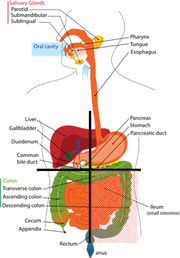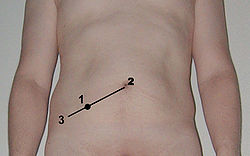
Rovsing's sign
Encyclopedia


Niels Thorkild Rovsing
Niels Thorkild Rovsing was a Danish surgeon remembered for describing Rovsing's sign.- Biography :...
, is a sign of appendicitis
Appendicitis
Appendicitis is a condition characterized by inflammation of the appendix. It is classified as a medical emergency and many cases require removal of the inflamed appendix, either by laparotomy or laparoscopy. Untreated, mortality is high, mainly because of the risk of rupture leading to...
. If palpation of the left lower quadrant of a person's abdomen
Abdomen
In vertebrates such as mammals the abdomen constitutes the part of the body between the thorax and pelvis. The region enclosed by the abdomen is termed the abdominal cavity...
results in more pain
Pain
Pain is an unpleasant sensation often caused by intense or damaging stimuli such as stubbing a toe, burning a finger, putting iodine on a cut, and bumping the "funny bone."...
in the right lower quadrant, the patient is said to have a positive Rovsing's sign and may have appendicitis.
In acute appendicitis, palpation in the left iliac fossa
Iliac fossa
The iliac fossa is a large, smooth, concave surface located on the internal surface of the ilium...
may produce pain in the right iliac fossa.
Referral of pain
This anomaly occurs because the painPain
Pain is an unpleasant sensation often caused by intense or damaging stimuli such as stubbing a toe, burning a finger, putting iodine on a cut, and bumping the "funny bone."...
nerve
Nerve
A peripheral nerve, or simply nerve, is an enclosed, cable-like bundle of peripheral axons . A nerve provides a common pathway for the electrochemical nerve impulses that are transmitted along each of the axons. Nerves are found only in the peripheral nervous system...
s deep in the intestine
Intestine
In human anatomy, the intestine is the segment of the alimentary canal extending from the pyloric sphincter of the stomach to the anus and, in humans and other mammals, consists of two segments, the small intestine and the large intestine...
s do not localize well to an exact spot on the abdominal wall, unlike pain nerves in muscle
Muscle
Muscle is a contractile tissue of animals and is derived from the mesodermal layer of embryonic germ cells. Muscle cells contain contractile filaments that move past each other and change the size of the cell. They are classified as skeletal, cardiac, or smooth muscles. Their function is to...
s. Pain from a stomach ulcer
Peptic ulcer
A peptic ulcer, also known as PUD or peptic ulcer disease, is the most common ulcer of an area of the gastrointestinal tract that is usually acidic and thus extremely painful. It is defined as mucosal erosions equal to or greater than 0.5 cm...
or gallstone
Gallstone
A gallstone is a crystalline concretion formed within the gallbladder by accretion of bile components. These calculi are formed in the gallbladder, but may pass distally into other parts of the biliary tract such as the cystic duct, common bile duct, pancreatic duct, or the ampulla of...
can be interpreted by the brain as pain from the stomach
Stomach
The stomach is a muscular, hollow, dilated part of the alimentary canal which functions as an important organ of the digestive tract in some animals, including vertebrates, echinoderms, insects , and molluscs. It is involved in the second phase of digestion, following mastication .The stomach is...
, liver
Liver
The liver is a vital organ present in vertebrates and some other animals. It has a wide range of functions, including detoxification, protein synthesis, and production of biochemicals necessary for digestion...
, gall bladder, duodenum
Duodenum
The duodenum is the first section of the small intestine in most higher vertebrates, including mammals, reptiles, and birds. In fish, the divisions of the small intestine are not as clear and the terms anterior intestine or proximal intestine may be used instead of duodenum...
, or first part of the small intestine
Small intestine
The small intestine is the part of the gastrointestinal tract following the stomach and followed by the large intestine, and is where much of the digestion and absorption of food takes place. In invertebrates such as worms, the terms "gastrointestinal tract" and "large intestine" are often used to...
. It will "refer" pain often to the mid upper abdomen.
Because the appendix
Vermiform appendix
The appendix is a blind-ended tube connected to the cecum , from which it develops embryologically. The cecum is a pouchlike structure of the colon...
is a piece of intestine, it follows a similar referral pattern. An appendix with some early inflammation may give a non-specific irritation somewhere near the umbilicus
Navel
The navel is a scar on the abdomen caused when the umbilical cord is removed from a newborn baby...
(belly button). Should the inflammation become severe, it may actually irritate the inner lining of the abdominal cavity called the peritoneum
Peritoneum
The peritoneum is the serous membrane that forms the lining of the abdominal cavity or the coelom — it covers most of the intra-abdominal organs — in amniotes and some invertebrates...
. This thin layer lies under or behind the abdominal wall muscles. Now the pain is "localized". If pressure is applied to the muscles of the right lower abdomen (or iliac fossa
Iliac fossa
The iliac fossa is a large, smooth, concave surface located on the internal surface of the ilium...
) near a very irritated appendix, then the muscle fibers in that area will be stretched and will hurt.
Process
A Rovsing's sign is elicited by pushing on the abdomen far away from the appendix in the left lower quadrant as in most people the appendix is in the right lower quadrant. While this maneuver stretches the entire peritoneal lining, it only causes pain in any location where the peritoneum is irritating the muscle. In the case of appendicitis, the pain is felt in the right lower quadrant despite pressure being placed elsewhere.Most practitioners push on the left lower quadrant to see where the patient complains of pain. If pain is felt in the right lower quadrant, then there may be an inflamed organ or piece of tissue in the right lower quadrant. The appendix is generally the prime suspect, although other pathology can also give a "positive" Rovsing's sign. If left lower quadrant pressure by the examiner leads only to left-sided pain or pain on both the left and right sides, then there may be some other pathologic
Pathology
Pathology is the precise study and diagnosis of disease. The word pathology is from Ancient Greek , pathos, "feeling, suffering"; and , -logia, "the study of". Pathologization, to pathologize, refers to the process of defining a condition or behavior as pathological, e.g. pathological gambling....
etiology
Etiology
Etiology is the study of causation, or origination. The word is derived from the Greek , aitiologia, "giving a reason for" ....
. This may include causes relating to the bladder
Urinary bladder
The urinary bladder is the organ that collects urine excreted by the kidneys before disposal by urination. A hollow muscular, and distensible organ, the bladder sits on the pelvic floor...
, uterus
Uterus
The uterus or womb is a major female hormone-responsive reproductive sex organ of most mammals including humans. One end, the cervix, opens into the vagina, while the other is connected to one or both fallopian tubes, depending on the species...
, ascending (right) colon
Colon (anatomy)
The colon is the last part of the digestive system in most vertebrates; it extracts water and salt from solid wastes before they are eliminated from the body, and is the site in which flora-aided fermentation of unabsorbed material occurs. Unlike the small intestine, the colon does not play a...
, fallopian tubes, ovaries, or other structures.
The eponym Rovsing sign is also used in patients with horse-shoe kidney, consisting of abdominal pain, nausea, and vomiting with hyperextension of the spine

